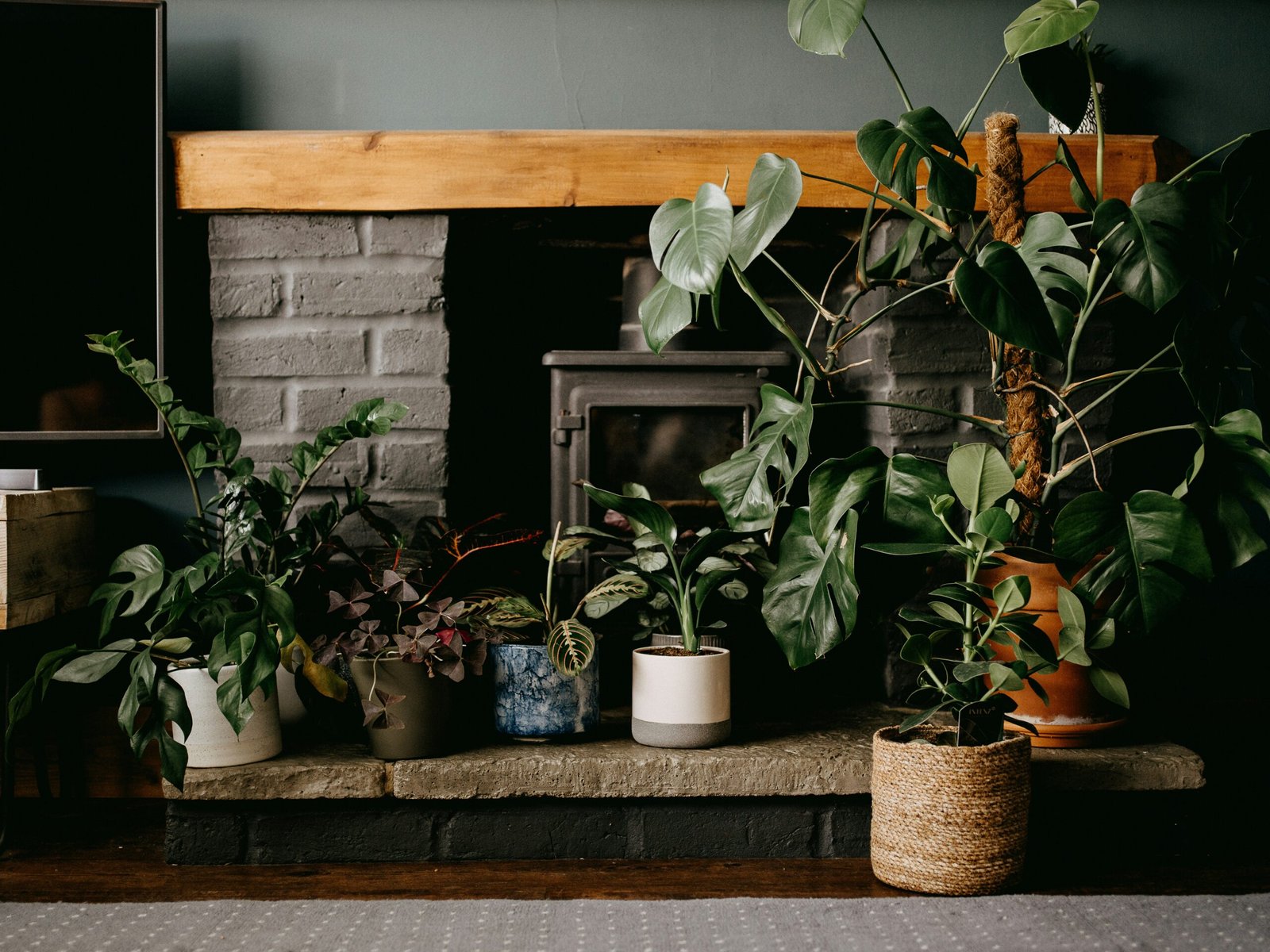Have you ever wanted your bedroom to feel calmer, fresher, and more alive with minimal effort?
How Can I Decorate My Bedroom With Plants?
Plants can transform your bedroom into a restorative sanctuary. You’ll get improved air quality, soothing green visuals, and a sense of being closer to nature without leaving home. This guide will walk you through practical, stylish, and low-maintenance ways to add plants to your bedroom.
Why use plants in your bedroom?
Plants do more than look pretty — they can affect mood, sleep quality, and the room’s microclimate. You’ll also find that caring for plants can be a relaxing, grounding ritual in your daily routine.
Benefits of Having Plants in Your Bedroom
Plants offer aesthetic, psychological, and physical benefits that make them a smart bedroom addition. Each plant brings a unique mix of color, texture, and function that can support your well-being.
Psychological and emotional benefits
You’ll likely feel calmer, less stressed, and more connected to nature simply by having plants nearby. The act of caring for a plant can also provide a gentle routine that helps your mental health.
Physical benefits: air quality, humidity, and sleep
Plants can help moderate humidity and, in some cases, remove trace pollutants from the air. While they’re not a replacement for good ventilation, they can contribute to a fresher-feeling room that supports better breathing and sleep.
Aesthetic and design benefits
Plants add organic shapes, color contrast, and texture that make your bedroom feel layered and intentional. Whether your style is minimal, bohemian, or modern, you’ll find plant choices that complement it.
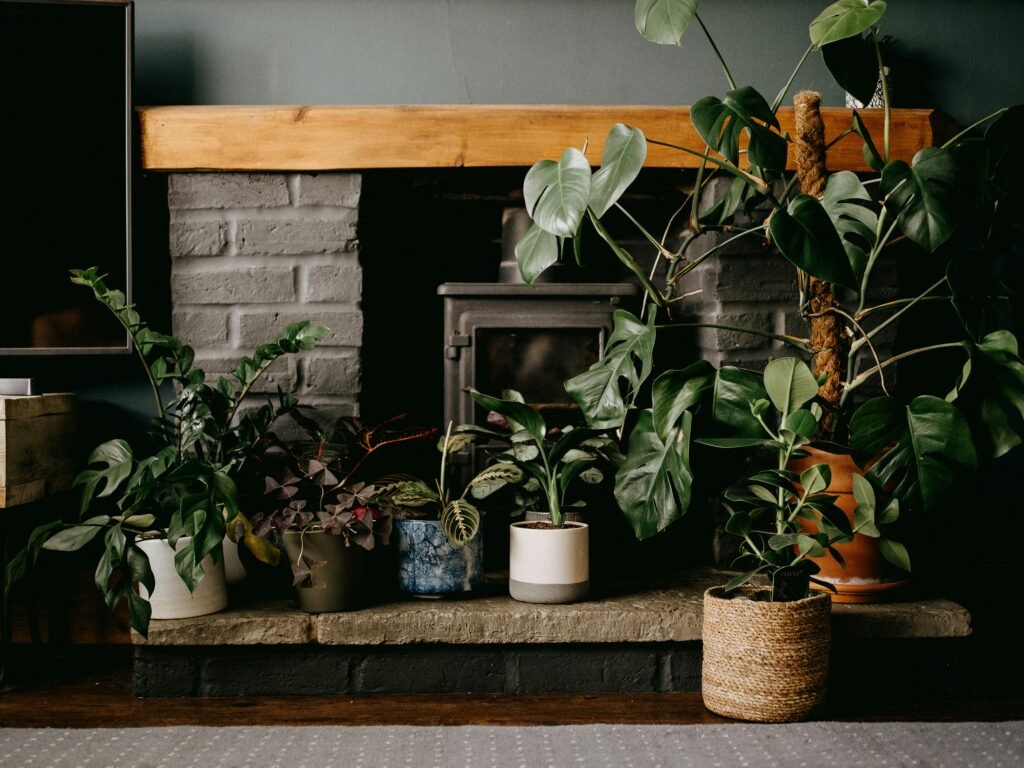
Choosing the Right Plants for Your Bedroom
Picking plants that match your light levels, time for care, and aesthetic goals will make the difference between a thriving green space and a collection of sad specimens.
Assess your bedroom light
You’ll need to observe where direct sunlight falls and how many hours of bright light you get. Light conditions guide which species will do well: low light rooms need tolerant plants, while sunny rooms can support sun-loving varieties.
Consider your schedule and maintenance preferences
If you travel or prefer low-effort care, choose drought-tolerant or slow-growing plants. If you enjoy regular plant care, you can select more finicky species that reward attention with faster growth or dramatic foliage.
Think about size and scale
Consider ceiling height, available floor space, and bedside surface area. You’ll want to balance large statement plants with small tabletop options so the room feels cohesive, not crowded.
Account for pets and allergies
If you have curious pets, choose non-toxic plants or place them out of reach. If you’re sensitive to pollen, favor foliage plants with minimal flowering.
Light-Based Plant Recommendations
Different plants thrive in different lighting. Use this table to match your bedroom’s light to suitable plants.
| Light level | Typical conditions | Recommended plants |
|---|---|---|
| Bright, direct sun | Sunny windows with several hours of direct sun | Succulents, cacti, string of pearls, kalanchoe |
| Bright, indirect | East/West windows or bright rooms with filtered light | Fiddle leaf fig (young), monstera, rubber plant, prayer plant |
| Moderate light | North-facing windows or rooms with some indirect sun | Pothos, snake plant, ZZ plant, peace lily |
| Low light | No direct sun, dim corners | ZZ plant, snake plant, philodendron, cast iron plant |
How to test your light level
You can judge light by how easily you can read without artificial light during the day. If words are clear and shadows are crisp, the light is bright. If the room is evenly lit but shadows are soft, it’s moderate. If it feels dim, you’re in low light territory.
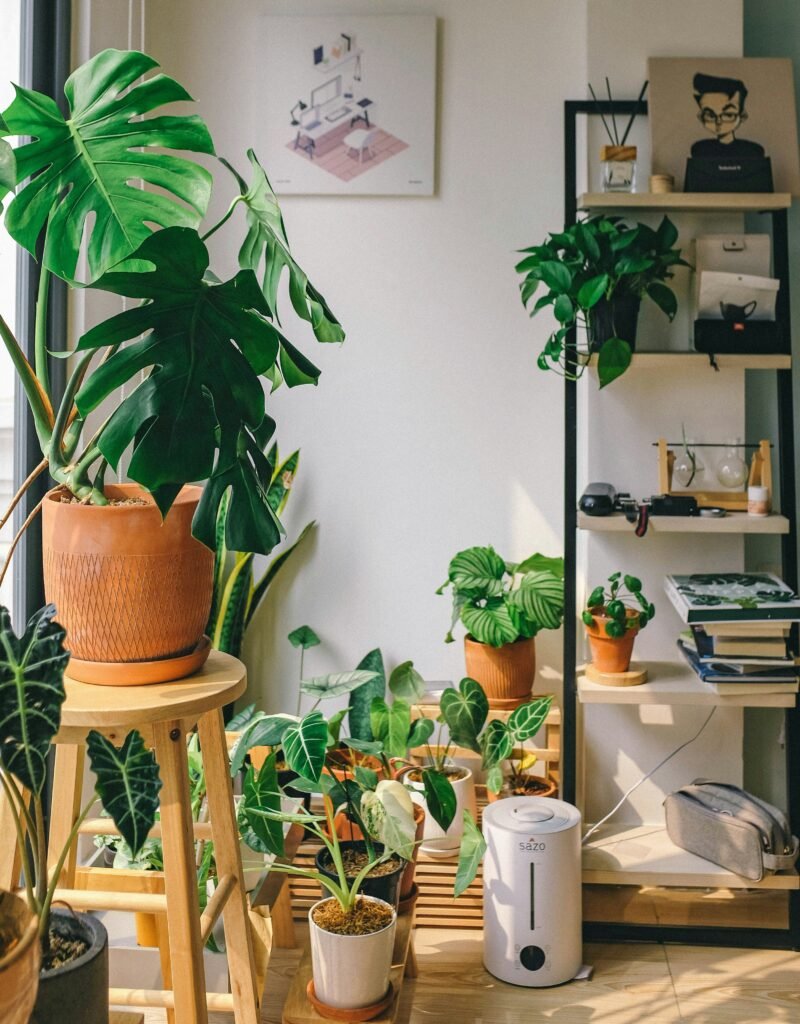
Styling Tips: Where to Place Plants
Placement affects visual balance and plant health. Thoughtful positioning will help your bedroom feel designed rather than cluttered.
Bedside plants
Small, compact plants on a nightstand add life without overwhelming the surface. You’ll want to avoid messy soil or water drips; choose plants with tidy growth habits.
Suggested bedside plants:
- Small snake plant (Sansevieria) varieties
- Baby rubber plant (Peperomia)
- Pothos in a small pot
Windowsills and ledges
Windowsills are perfect for sun-loving or medium-light plants. You’ll get the best growth when plants receive light consistent with their needs.
Floor plants and statement pieces
A large potted plant in a corner anchors the room and adds vertical interest. You’ll see how a tall fiddle leaf fig, bird of paradise, or rubber plant can become a focal point.
Hanging planters and shelves
Hanging plants save floor space and let you create visual layers. Trailing plants like pothos or string of hearts look great cascading from shelves or macramé hangers.
Shelves and bookcases
You can intersperse plants with books and decor to soften a bookshelf. You’ll want to mix plant sizes and pot textures to avoid monotony.
Plant & Pot Pairing: Containers, Drainage, and Style
Choosing the right pot matters for plant health and aesthetic cohesion. You’ll want a balance between function and style.
Importance of drainage
Most houseplants need well-draining pots. You’ll avoid root rot by selecting pots with drainage holes and using appropriate potting mixes. If a decorative pot lacks drainage, place the plant in a nursery pot and set it inside the outer container with a liner.
Pot materials and their pros/cons
- Terracotta: Porous, helps soil dry out, classic look. Good for succulents and plants that like dry conditions.
- Ceramic/glazed: Retains moisture longer, available in many colors and styles. Good for moisture-loving plants.
- Plastic: Lightweight, inexpensive, retains moisture. Good for large pots or budget-conscious setups.
- Wicker or baskets: Aesthetic, often require liner for moisture control.
Matching pot size to plant size
Pick a pot that’s slightly larger than the root ball — typically 1–2 inches larger in diameter for small plants, and up to 4 inches for larger ones. Overpotting can lead to soggy soil and slower growth.
Styling tips for cohesive decor
Choose pots that reflect your room’s palette and texture. Mix matte ceramics with glazed finishes, or group two to three pots of similar tones for a curated look.
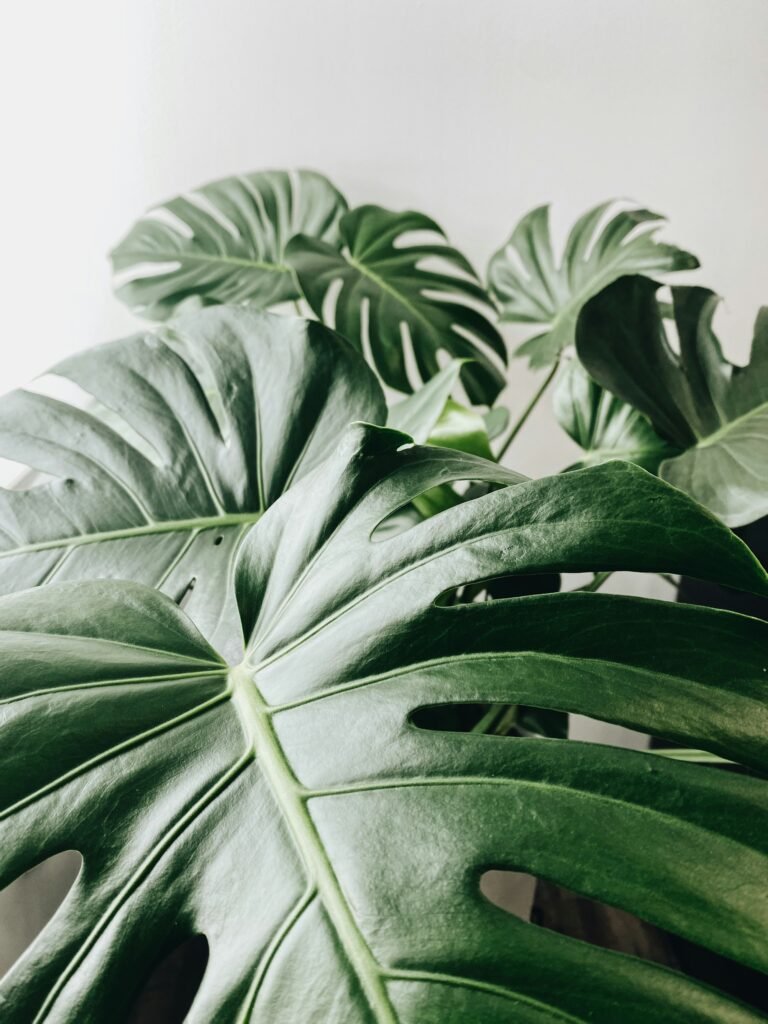
Creating Plant Groupings and Arrangements
Grouping plants creates a mini indoor garden and boosts humidity slightly, which many plants appreciate. You’ll also get an eye-catching display with varied heights and leaf shapes.
Layering for visual interest
Place taller plants in the back, medium in the middle, and small in front. Vary pot heights using plant stands or stacked books to build depth.
Repetition and variety
Repeat a plant or pot style to create cohesion, then add one or two contrasting elements to keep it interesting. You’ll want balance rather than strict symmetry.
Example groupings for different styles
- Minimal: Three plants in simple white or neutral pots, each with distinct leaf shapes.
- Boho: Macramé hangers with trailing plants plus woven baskets and textured pots.
- Modern: Sleek matte pots, sculptural plants like snake plant or monstera, and minimal accessories.
Low-Maintenance Plant Options
If you want a green bedroom but minimal upkeep, these plants are hard to kill and forgiving.
| Plant | Light needs | Water needs |
|---|---|---|
| Snake plant (Sansevieria) | Low to bright indirect | Infrequent — every 2–6 weeks |
| ZZ plant (Zamioculcas) | Low to bright indirect | Very low — every 2–6 weeks |
| Pothos | Low to bright indirect | Moderate — once every 1–2 weeks |
| Spider plant | Bright indirect | Moderate — once per week |
| Cast iron plant | Low | Very low — sparse watering |
Drought-tolerant care guide
You’ll water thoroughly, then let the soil dry partially before watering again. These plants handle occasional neglect well, which is great for busy lifestyles.
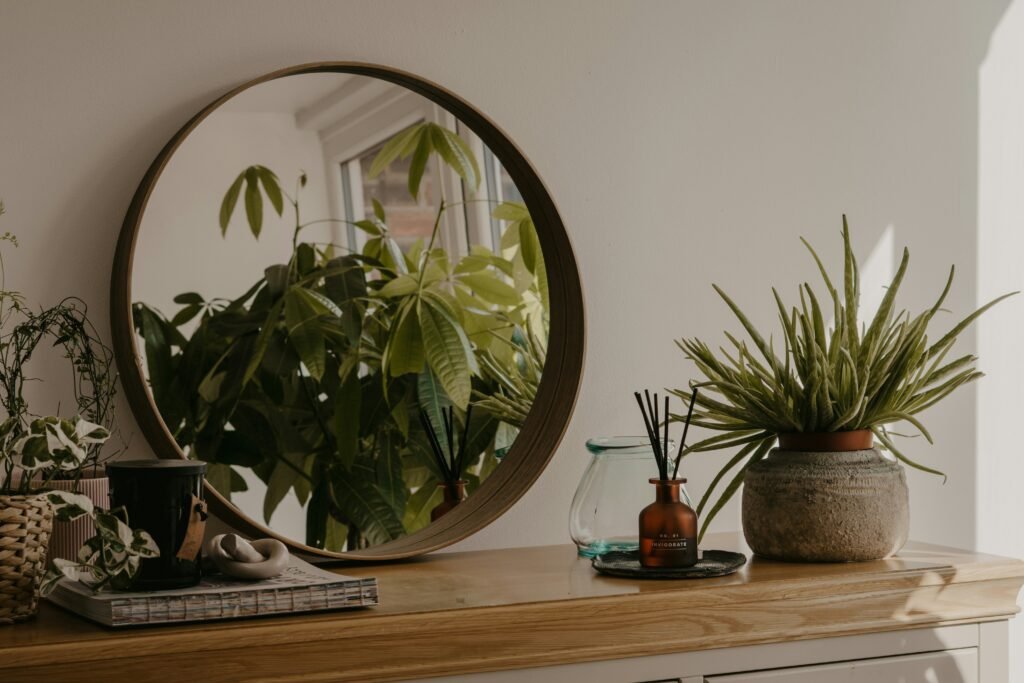
Plants for Small Bedrooms
You don’t need a large space to have a lush bedroom. Strategic choices and vertical solutions will make your room feel spacious.
Vertical and hanging solutions
You’ll save floor space by using wall-mounted planters, hanging baskets, or stacking plants on shelves. Trailing plants add drama without taking up square footage.
Compact plant picks
Look for compact varieties like baby rubber plant (Peperomia obtusifolia), small ferns, and small calatheas. Succulent clusters on a windowsill also work well.
Use mirrors to amplify greens
Mirrors reflect plants and light, making your room feel larger and more verdant without adding more plants.
Plant Care Basics: Watering, Soil, and Fertilizer
Simple routines and appropriate products will keep your bedroom plants healthy and vibrant.
Watering: signs and schedule
You’ll check soil moisture by sticking your finger an inch into the soil. If it’s dry at that depth, it’s time to water. Overwatering is a common mistake — many plants prefer slightly dry cycles.
Soil and potting mixes
Use general-purpose potting mix for most plants. Succulents and cacti need a mix with more sand or perlite for extra drainage. Repot when plants become root-bound or the soil degrades.
Fertilizer basics
Feed during the growing season (spring and summer) with a balanced, diluted houseplant fertilizer every 4–6 weeks. Stop or reduce feeding in fall and winter when growth slows.

Dealing with Light Challenges
You’ll encounter rooms with low or inconsistent light. There are ways to compensate without sacrificing plant health.
Low-light plant options
Choose tolerant species like ZZ plant, snake plant, and pothos. These thrive in dimmer rooms and still provide lush foliage.
Increasing available light
You can move plants closer to windows, use sheer curtains to diffuse harsh sun, or add grow lights for supplemental light if natural light is insufficient.
Using grow lights effectively
LED grow lights are energy-efficient and provide wavelengths that promote plant growth. Position a light 12–24 inches above plants and run it for 8–12 hours daily to mimic daylight.
Humidity and Temperature Considerations
Bedrooms can be dry, especially with heating or air conditioning. You’ll want to match plants to your room’s humidity or take steps to raise it.
Humidity-raising strategies
Group plants together, use pebble trays with water under pots, or run a cool-mist humidifier. Bathrooms with adequate light are also great places for tropical plants.
Best temperature ranges
Most houseplants thrive between 60–75°F (15–24°C). Avoid placing plants next to cold drafts or heating vents that cause temperature swings.
Pet-Safe Plant Options
If pets have access to your bedroom, prioritize non-toxic plants or keep toxic ones out of reach.
| Safe for pets? | Plant examples |
|---|---|
| Generally safe | Spider plant, Boston fern, calathea, haworthia, ponytail palm |
| Potentially toxic | Pothos, philodendron, snake plant, peace lily — keep away from pets |
Keeping toxic plants safe
You’ll place toxic plants high on shelves, use hanging baskets, or opt for safe alternatives to protect your pets.
Seasonal Care and Rotation
Your plants’ needs change with seasons. Adjust watering, light exposure, and feeding to match growth cycles.
Winter care
You’ll water less and cut back on fertilizer in winter. Move plants away from drafty windows and ensure they get the most light possible during short daylight hours.
Summer care
Increase watering frequency as plants grow more actively. Rotate pots to keep growth even and prune as needed to control size.
Troubleshooting Common Issues
You’ll encounter issues like yellowing leaves, pests, and leggy growth. Quick identification helps you address problems before they worsen.
Yellow leaves and overwatering
Yellow leaves, especially at the base, often signal overwatering. Check soil moisture and consider repotting if roots are mushy.
Brown leaf tips and underwatering
Dry seashell-like leaf tips usually mean lack of humidity or irregular watering. Increase humidity and maintain consistent watering habits.
Pests: dealing with common invaders
Mealybugs, spider mites, and scale can appear on houseplants. You’ll remove pests by wiping leaves, using insecticidal soap, or isolating affected plants until treated.
Leggy plants and insufficient light
If plants are stretching toward the light, you’ll need to move them to brighter spots or provide supplemental lighting. Regular pruning also encourages bushier growth.
Propagation: Expand Your Collection for Free
You’ll save money and enjoy watching new plants grow by propagating from cuttings or divisions.
Stem cuttings
Many plants like pothos, philodendron, and coleus root easily in water. You’ll snip a stem below a node, place it in water, and wait for roots to form before potting.
Division and offsets
Plants that clump, like snake plants or peace lilies, can be divided at repotting. You’ll gently separate rooted sections and pot them individually.
Leaf cuttings
Succulents and some begonias can regenerate from leaves. You’ll let a leaf callus, place it on soil, and encourage roots with bright indirect light.
Creating a Plant Care Routine
A simple routine keeps your bedroom plants thriving without taking too much time.
- Weekly: Check soil moisture, wipe dust from leaves, rotate pots for even light.
- Monthly: Feed during growing season, inspect for pests, prune as needed.
- Seasonally: Repot if necessary, adjust watering and light exposure.
Quick checklist for daily or weekly habits
You’ll glance at plants when you enter the room. Look for signs of stress, dead leaves, or droopiness and address issues early.
Budget-Friendly Ways to Add Plants
You don’t need to spend a lot to create a lush bedroom.
Affordable sources
Local plant swaps, cuttings from friends, discount nurseries, and big-box stores often have budget-friendly plants. You’ll propagate cuttings to multiply your collection.
DIY pots and stands
Upcycle jars, tin cans, or wooden crates as planters. You’ll save money and add personalized decor touches with paint or fabric.
Long-Term Considerations: Growth and Commitment
Plants grow over time. You’ll want to plan for larger pots, pruning, and possibly relocating plants as they mature.
When to repot
Repot when roots circle the pot, growth slows, or soil becomes compacted. You’ll typically repot every 1–3 years depending on plant and pot size.
Allowing room to grow
Place plants where they can reach their potential size without crowding furniture. You’ll prune or train plants as needed to maintain your desired look.
Final Styling Ideas and Inspiration
With the basics covered, you’ll be ready to create a bedroom that feels personal and alive.
Mix textures and leaf shapes
Combine broad leaves with delicate ferns and trailing vines to create contrast. You’ll get a layered, interesting look that feels curated.
Use plants as living artwork
Hang a collection of small pots on the wall or create a gallery shelf with plants as the focal point. You’ll find plants can replace framed pictures when placed thoughtfully.
Seasonal refreshes
Switch pots, add new plants, or change basket liners to keep the room feeling fresh. You’ll enjoy the evolving look as your plants grow and change.
Quick Reference Table: Best Bedroom Plants by Need
This compact table helps you pick plants based on your key needs.
| Goal | Light | Best plants |
|---|---|---|
| Low maintenance | Low to moderate | ZZ plant, snake plant, pothos |
| Improve humidity | Moderate to bright | Boston fern, peace lily, calathea |
| Small bedside | Moderate to bright | Peperomia, baby rubber plant, succulent |
| Statement floor plant | Bright indirect | Fiddle leaf fig, rubber plant, bird of paradise |
| Pet-safe | Variable | Calathea, haworthia, spider plant |
Final Checklist: Getting Started Today
This short checklist will help you begin decorating your bedroom with plants right away.
- Assess your bedroom light and pick suitable plants.
- Choose pots with proper drainage and matching style.
- Start with 3–5 plants in varied heights for balance.
- Create a simple weekly care routine.
- Propagate or buy additional plants as your confidence grows.
You’re ready to transform your bedroom into a greener, calmer space. With the right plant choices, consistent care, and a few styling tricks, your bedroom will feel like a restorative haven you look forward to spending time in every day.
